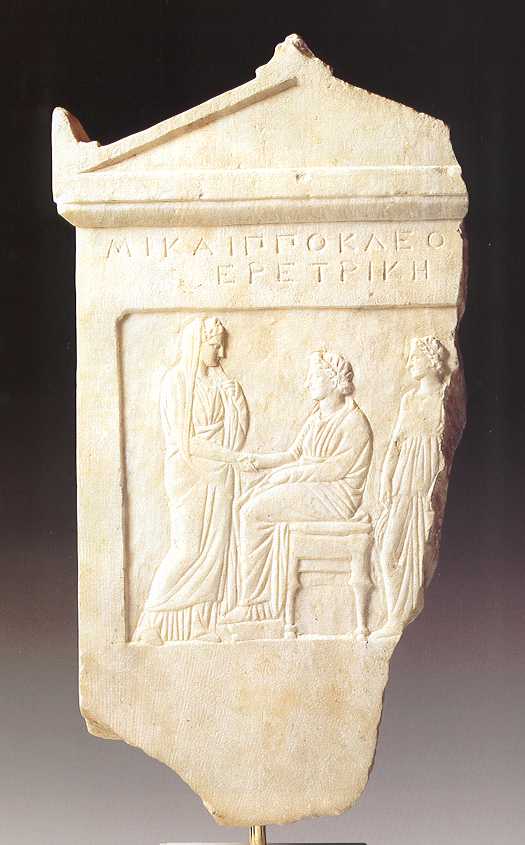
The archaeological excavations in the areas where the stations of the new Athens metropolitan railway were and are going to be built have brought to light about 30.000 finds. The excavations in the Kerameikos station pit in the area of the ancient Athenian cemetery have revealed the exquisite 4th c. tomb relief of Mika.
Mika's stele is 0.55 m. tall, made of marble, and very well preserved. The stele is composed of three parts: the pediment like top, the inscription, and the reception (dexiosis) depiction.
 |
The typical depiction of a reception has been carved in the lower iconographic part of the stele. Most probably the depiction was limited to the three female figures that have been preserved. The sitted lady in the middle must be Mika. The standing female on the left, must be a close relative or a friend who is shaking hands with Mika and saying goodbye to her as Mika is beginning her voyage to the underworld. The young girl on the right might be Mika's daughter or a servant, who is watching the farewell.
The reception is a well known depiction theme in ancient Greek relief making and it reached its artistic peak in the last quarter of the 4th c. Mika's stele reveals the skilful hand of a real artist. He does not just carve a reception scene but he manages to tell the story of Mika with a few sharp lines. The plain straight lines of Mika's legs and the austere design of the stool (difros) she sits on contrasted with the legs of the other two females along with the folds of the garments wore by those women, create the illusion of motion. On the one hand, Mika in the center is dead and static. The way she sits on the stool shows that she has accepted her fate: leave from this world. On the other hand, the woman who is shaking hands with her is about to leave. The way her feet are drawn shows that she is ready to walk away. Moreover, the young girl on the right is drawn with her legs bent forward as the artist wanted to show that she is still alive.
The touching scene of Mika's farewell is revealed by the lifted left arm of the standing woman on the left. She is holding her garment in a motion of grief while she is staring at Mika with love. The tomb stelae of this type show the affection Greeks and especially Athenians wanted to show for their dead relatives.
Catalog no 446 of the The City Beneath the City exhibition in the Museum of Cycladic Art, Athens, Greece.